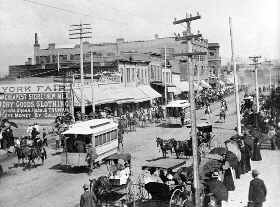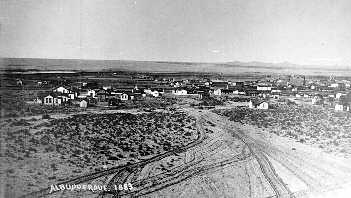 |
Albuquerque Museum Archives |
Although Albuquerque became an official part of the United States in 1848 with General Stephen Watts Kearny's "conquest," most of the Anglo influence did not penetrate this remote region until after the Civil War. During the Civil War, there was a U.S. fort in Albuquerque, but the important battles took place elsewhere. At the end of the war, Albuquerque took on some of the appearance of the usual frontier towns; that is, the population now included some U.S. soldiers, Anglo businessmen (in the wagon train business), a few Anglo ranchers, and a more heterogeneous group of Indians. The town also supported the required new "service" industries, notably saloons and hotels. The major change for Albuquerque was the introduction of the Atlantic and Pacific Railway (later the Atchison, Topeka, and Santa Fe) in 1880. Actually, the fight over where to put the railway reflected the mood of the times. Many Albuquerque residents argued against having the railway, believing that it would hurt their investments in wagon transport. Others in the town saw the potential for new economic growth. The "solution" was, in fact, to bypass Albuquerque by a mile and establish New Albuquerque, at first merely a group of railway buildings at Railway (now Central Avenue) and First Streets. For years, New and Old Albuquerque were "connected" by a horse-drawn street car.
The railway provided access to a new market for Albuquerque's exports (Kansas City) and to materials from the east. Commercial plaster and window glass changed the appearance of Albuquerque's houses, but milled lumber was particularly sought after. The lumber was used in building construction, but especially for boardwalks. Flooding along Railway Avenue was so common that boardwalks and building entrances were built as much as five feet above ground level. The architectural style that emerged, called "New Mexico Territorial" was an odd blend of Hispanic and Anglo traditions. During the Territorial Period, and for some time after statehood, the preferred way of building was Anglo. Thus, the first buildings on the University of New Mexico campus were red brick and would not have been out of place in New York or Maryland.
 |
Albuquerque grew rapidly during the Territorial Period. By 1900, the incorporated city contained 6,000 people, but the population was closer to 10,000 if the population in adjacent unincorporated communities was taken into consideration. The surge of growth is reflected particularly in two ways: citizens of Albuquerque were demanding better services; and companies sought franchises for profit, whether or not they intended to provide adequate services. Records of city ordinances and council meetings show that, between 1885 and 1890, the majority of ordinances related to the regulation of dance halls, gambling halls, and saloons. In addition, the first sewer unit was contracted for and completed in 1888; a volunteer fire department was organized in 1885; and in 1890, the city council set aside approximately $3,000 to build floodwater dikes.
The dikes were not well constructed, and in 1903, flooding was so severe that the Santa Fe Railway tracks and most of the business district were completely flooded. A number of accidents had occurred at the intersection of Coal and the railway tracks, and after much citizen complaint, a viaduct over the tracks was constructed in 1900. Again, construction was shoddy, a great deal of city money was spent for constant repairs, and federal government inspectors declared it unfit in 1920. These problems were not unique to Albuquerque but rather characterized the growth of the country's frontier cities. As a counter- balance to the problems, incompetence, mismanagement, and profiteering, Albuquerque had generous, public-minded citizens as well. Joshua Reynolds, for example, gave the city its first library in 1900. New Mexico was granted statehood in 1912, demonstrating its relatively rapid growth, and the new state institutions certainly had an impact on the character Albuquerque was to assume.
Albuquerque's clean air and high altitude were important to another aspect of the city's growth. In the first part of the 20th century, the city became a mecca for those suffering from tuberculosis. The sanitariums, most notably Presbyterian Hospital, were built on the outskirts of the city. The city eventually grew to encompass them. The provision of health services has been an important aspect of Albuquerque's economy.
Further progress for the city, and its continued growth, were assured by the U.S. military with the establishment of Kirtland Air Force Base and Sandia Laboratories and Base. In the latter case, it was the relative obscurity of New Mexico (and therefore its strategic safety) that led to the establishment of the facility at Los Alamos during the Second World War. Because the railroad (necessary for the transport of equipment and troops) was in Albuquerque, the activities involved in creating and maintaining Los Alamos had tremendous impact on the growth of Albuquerque, and it was the economy of war that pushed Albuquerque into the sprawling urban center it is today.
(Up to Section III, Back to Hispanic Influence, On to Facts of Modern Albuquerque Life)